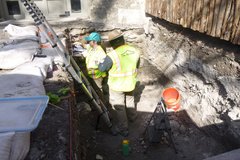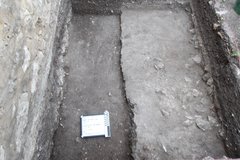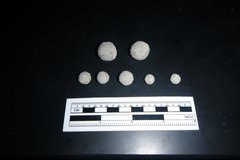Archaeologists were active in four excavation units this week. In EUs 2B and 6 archaeologists completed excavation and spent the week completing end of unit documentation. This included photographs and detailed soil profile mapping and descriptions.
Long Barrack Archaeology Update - March 8


Excavations within EU-10 reached an approximate depth of 60 cm below surface. Archaeologists delineated a builders’ trench along the wall of the Long Barrack from an earlier soil deposit east of the trench. The builders’ trench had more “modern” artifacts such as a glass stopper and metal nails. The earlier soil deposit within the eastern portion of the unit contained Spanish Colonial ceramics, such as Galera ware and Tonala Glazed.
Archaeologists in EU-12 reached an approximate depth of 1 meter below surface. Similar to EU-10, there are two distinct soil deposits that divide the unit. Archaeologists encountered a limestone cobble deposit on the eastern side of the unit that may be an intentional surface. In the soils immediately above this deposit multiple pieces of ammunition. Upon closer inspection the ammunition was determined to be “buck and ball,” popular during the 18th and early 19th centuries. Archaeologists continue to excavate deeper along the Long Barrack wall but there is a noticeable decrease in artifacts.




